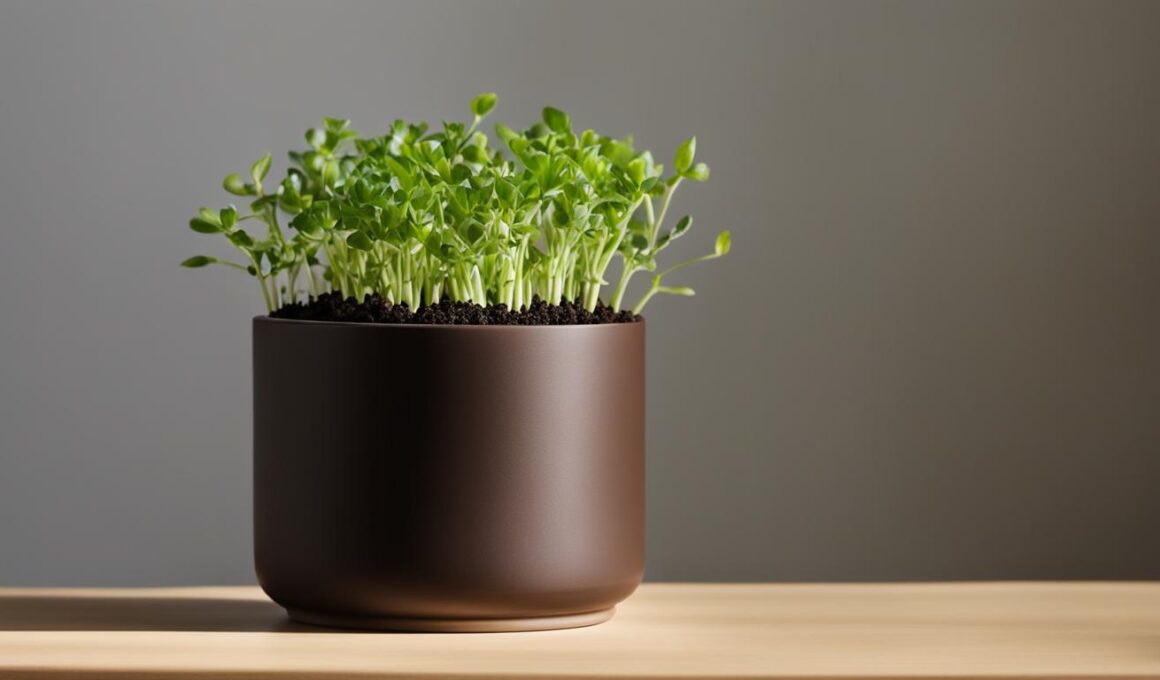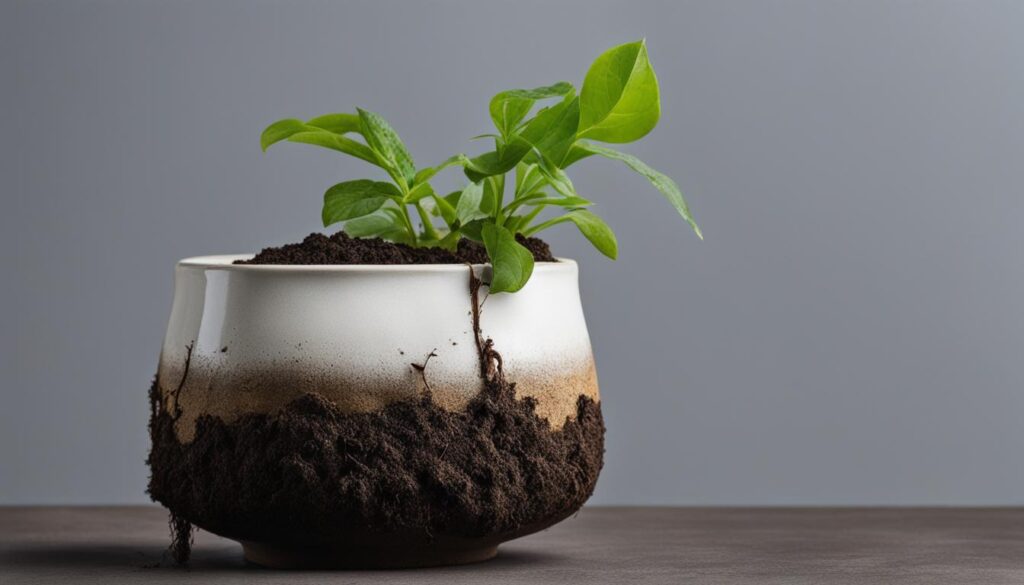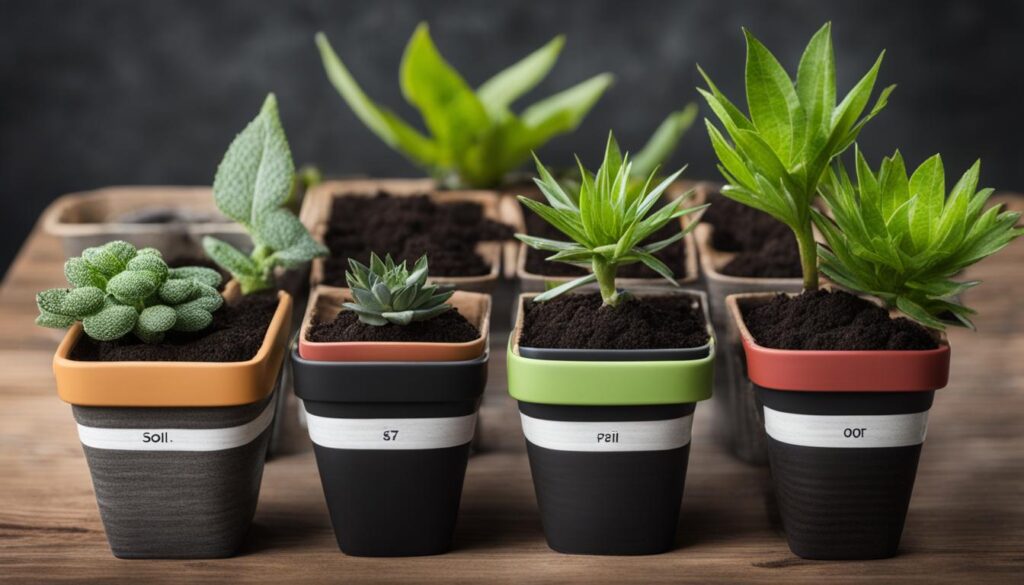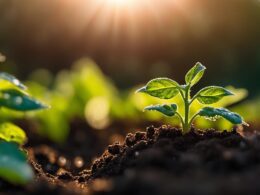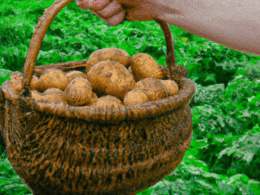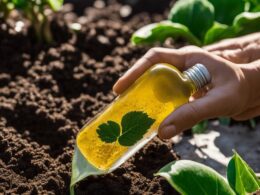When it comes to planting in pots, determining the right amount of soil is essential for the health and growth of your plants. Pots should have enough soil to support the plants and elevate them to the appropriate height. This means the soil should be below the rim of the pot to prevent spillage during watering. Additionally, it is important to use potting soil rather than regular garden soil for optimal plant growth.
Key Takeaways:
- Using the right amount of soil in a pot is crucial for plant health and growth.
- Soil should be below the rim of the pot to prevent spillage during watering.
- Potting soil is recommended for optimal plant growth in pots.
- Determining the appropriate amount of soil can be challenging due to container sizes and shapes.
- Keeping notes on your potting experiences can help you estimate the right amount of soil for future plantings.
The Effects of Too Much Soil in a Pot
Filling pots with too much soil can have negative consequences for your plants and create a messy situation. Many gardeners mistakenly overfill their pots, thinking that the soil will settle after watering. However, moist soil may not sink down as much as expected, resulting in excess soil spilling out of the pot. This can lead to soil spillage and muddy messes, which can be both inconvenient and unsightly.
When there is too much soil in a pot, it can also affect the watering process. Excess soil can retain more moisture than necessary, leading to waterlogged roots and increased risk of root rot. Additionally, the excess soil can prevent proper drainage, causing the water to pool at the bottom of the pot. This can further contribute to root rot and other moisture-related issues that can harm the overall health of your plants.
“The key to successful potting is finding the right balance of soil to promote healthy plant growth without causing any negative effects,” says gardening expert Jane Smith.
To avoid the negative effects of too much soil in a pot, it is important to fill the pot with the appropriate amount of soil. Leave some space below the rim of the pot to prevent soil spillage during watering. It is also crucial to use potting soil specifically formulated for container gardening. Potting soil is designed to provide the necessary drainage and aeration that regular garden soil may lack.
| Issues Caused by Too Much Soil | Prevention |
|---|---|
| Soil spillage and messy appearance | Fill the pot with the appropriate amount of soil, leaving space below the rim |
| Waterlogged roots and increased risk of root rot | Use potting soil specifically formulated for container gardening |
| Impaired drainage and excessive moisture | Ensure proper drainage holes in the pot and choose a well-draining potting mix |
By understanding the effects of too much soil in a pot and taking the necessary precautions, you can create an optimal environment for your plants to thrive. Remember, providing the right amount of soil is essential for their health and overall growth.
The Consequences of Too Little Soil in a Pot
Using too little soil in a pot can have detrimental effects on both the health and aesthetics of your plants. Insufficient soil restricts root growth and limits access to vital resources such as water, nutrients, and oxygen. This can result in stunted plant growth and poor overall health. Additionally, plants in pots with too little soil may struggle to maintain stability, making them more susceptible to toppling over.
Furthermore, inadequate soil can negatively impact the esthetics of your potted plants. With insufficient soil, plants may appear unsightly, with leaves drooping and stems bending due to inadequate support. This can detract from the visual appeal and beauty of your plant arrangement, undermining the overall aesthetic impact you desire.
To ensure optimal plant development, it is crucial to provide sufficient soil in your pots. Adding more soil allows plants to establish a stronger root system, access more light, and benefit from better air circulation, all of which contribute to healthier and more robust growth. By providing the right amount of soil, you can create a favorable environment for your plants to thrive both in terms of health and visual appeal.
The Importance of Soil Volume
When considering the soil volume for your potted plants, it’s essential to remember that it directly affects plant health and overall performance. The correct soil volume allows roots to spread out and explore a larger area, absorbing water and nutrients effectively. It also provides stability and support for the plants, preventing them from toppling over due to a weak root system.
Without adequate soil volume, plants may suffer from various issues, including nutrient deficiencies, waterlogging, and poor root development. Insufficient soil also limits the buffering capacity of the pot, making it harder to maintain stable moisture levels. Inadequate moisture control can lead to root rot, stressing the plants and making them more susceptible to diseases and pests.
By providing the right amount of soil, you create the optimal conditions for plant growth, ensuring that they receive the necessary resources and support to thrive. Investing in sufficient soil volume is an essential aspect of successful container gardening and will contribute to the long-term health and vitality of your potted plants.
| Consequences of Too Little Soil in a Pot | Recommendations |
|---|---|
| Restricted root growth | Ensure a sufficient volume of soil to allow for root expansion. |
| Limited access to water, nutrients, and oxygen | Provide enough soil to enable proper resource absorption and circulation. |
| Weakened stability | Add adequate soil to prevent plants from toppling over. |
| Unsightly appearance | Use sufficient soil to support plant structure and maintain aesthetic appeal. |
As evident from the consequences discussed, too little soil in a pot can have significant negative implications for your plants. By prioritizing the right amount of soil volume, you can create an environment that promotes healthy growth and enhances the visual appeal of your potted plants.
Factors Contributing to Insufficient Soil in Pots
When it comes to planting in pots, new gardeners may encounter challenges in determining the right amount of soil needed. Lack of experience or knowledge can lead to insufficient soil in their planters, which can have negative consequences for plant health and growth. Additionally, there are other factors that contribute to this issue, such as dry soil and the size of the planters.
Dry Soil
Dry soil can be a common issue that affects the amount of soil in pots. When soil is dry, it tends to settle more after watering, resulting in lower levels than initially anticipated. This can leave plants with inadequate soil, limiting their root growth and access to vital resources such as water and nutrients. It’s important for gardeners to ensure that the soil is adequately moistened before determining the final amount needed for their pots.
Size of Planters
The size of the planter plays a significant role in determining the amount of soil needed. Larger planters require more soil to provide sufficient space for root growth and to support the overall stability of the plants. Sometimes, gardeners may underestimate the amount of soil required for larger planters or try to save money by using less soil. However, using too little soil can hinder plant development and lead to stunted growth. It’s essential for gardeners to consider the size of their planters and ensure that an adequate amount of soil is used.
| Factors | Effects |
|---|---|
| Dry soil | Higher settling after watering, leading to lower soil levels |
| Size of planters | Inadequate soil for root growth and stability, hindering plant development |
To prevent insufficient soil in pots, it’s crucial for new gardeners to be mindful of these factors. Ensuring that the soil is adequately moistened and considering the size of the planters can help gardeners provide the optimal environment for their plants to thrive. By understanding these contributing factors and taking the necessary steps to address them, gardeners can promote healthy plant growth and create a visually appealing garden.
Tips for Determining the Right Amount of Soil
Estimating the appropriate amount of soil for a pot can be challenging due to various container sizes and shapes. However, there are some guidelines you can follow to ensure you have enough soil for your plants. One way to estimate the soil amount is by considering the container size. Containers are often measured in both inches and gallons, providing a reference for the amount of soil needed. Keep in mind that larger containers require more soil, so be sure to account for this when determining the quantity.
Maintaining notes on the pots you use and the amount of soil required can also be helpful. By keeping track of your potting experiences, you can develop a realistic estimate for future planting endeavors. Note down the size of the pot, the amount of soil used, and any observations you make about how the plants grow in those pots. This way, you can refer back to your notes for future reference and adjust the soil amount accordingly.
Remember, using potting soil instead of regular garden soil is essential in providing the best environment for your plants to thrive.
In addition to container size and note-taking, it’s important to consider soil compression when estimating the right amount of soil. When you moisten and press down the soil, it compresses, occupying less space than when dry. As a result, you may need more dry soil than you initially estimated. It’s recommended to account for a 15% to 20% increase in the required amount of dry soil to compensate for this compression.
By taking these factors into consideration and following these tips, you can determine the optimal amount of soil for each pot. This will ensure that your plants have enough soil to support their growth and development, promoting healthy and thriving plant life in your containers.
| Container Size (Inches) | Container Size (Gallons) | Recommended Soil Amount (Dry) |
|---|---|---|
| 6-8 | 0.5-1 | 1-1.5 quarts |
| 8-10 | 1-3 | 2-4 quarts |
| 10-12 | 3-5 | 4-6 quarts |
| 12-16 | 5-10 | 8-12 quarts |
Is the Amount of Soil in a Pot Different Depending on the Size of the Pot?
When it comes to gardening, the size of the pot can directly impact the amount of soil needed. A comprehensive guide on soil depth can help determine how much soil is necessary for different pot sizes. Understanding this can ensure proper growth and health for your plants.
Conclusion
Achieving the optimal soil amount in your pot is essential for promoting healthy plant growth. Balancing the right amount of soil ensures that your plants have the support they need to thrive and reach their full potential.
Remember, too much soil can lead to messy spillage and excess soil overflow. On the other hand, too little soil can negatively impact plant health and aesthetics, hindering their development. Finding the sweet spot is crucial.
Factors such as container size and soil compression play a role in determining the appropriate soil amount. By keeping notes on your potting experiences and estimating based on container sizes, you can develop a realistic estimate for future planting endeavors.
Lastly, always opt for using potting soil instead of regular garden soil. Potting soil provides the ideal environment for your plants to thrive and ensures they receive the necessary nutrients for healthy growth.
FAQ
How much soil should I put in a pot?
The soil in a pot should be below the rim to prevent spillage during watering. Make sure the pot has enough soil to support the plants and elevate them to the appropriate height.
What happens if I put too much soil in a pot?
Filling pots with too much soil can lead to soil spillage and messy situations. Moist soil may not settle as much as expected, resulting in excess soil overflowing from the pot.
What are the consequences of using too little soil in a pot?
Insufficient soil can restrict root growth, limit access to light, and decrease air circulation, all of which are essential for plant health. Adding more soil can significantly enhance plant growth.
Why is there sometimes insufficient soil in a pot?
Factors contributing to insufficient soil include a lack of awareness about the required amount, soil settling after watering, and underestimating the amount needed for larger planters.
How can I estimate the appropriate amount of soil for a pot?
Consider the size of the pot and account for soil compression, which can increase the required amount of dry soil by 15% to 20%. Keeping notes on your potting experiences can help develop a realistic estimate.
What should I use for potting, regular garden soil or potting soil?
It is important to use potting soil instead of regular garden soil for optimal plant growth. Potting soil provides the best environment for your plants to thrive.
Why is achieving the right amount of soil in a pot important?
Achieving the right amount of soil is crucial for fostering healthy plant growth. Too much soil can cause spillage, while too little soil can limit plant health and aesthetics.





